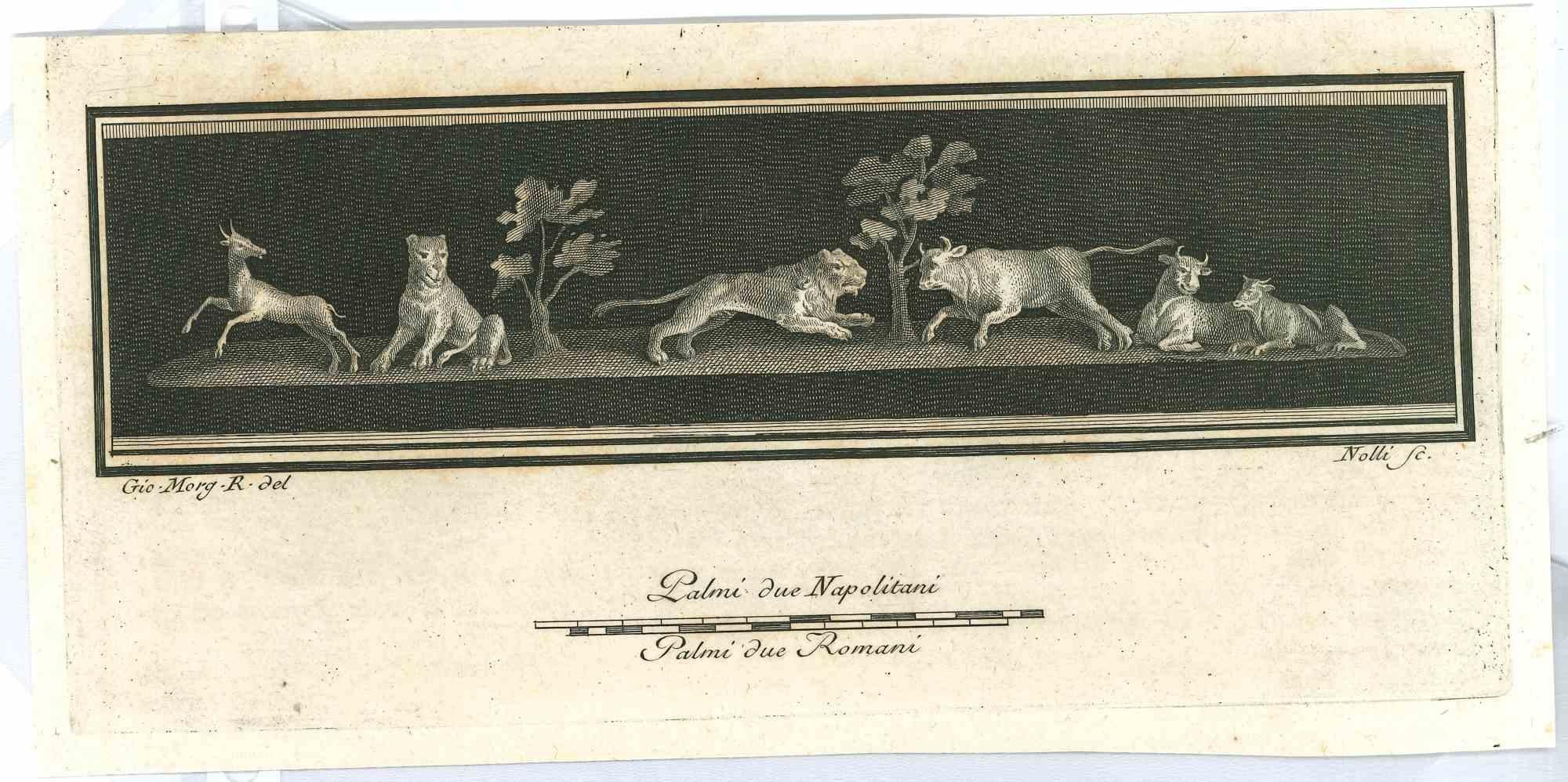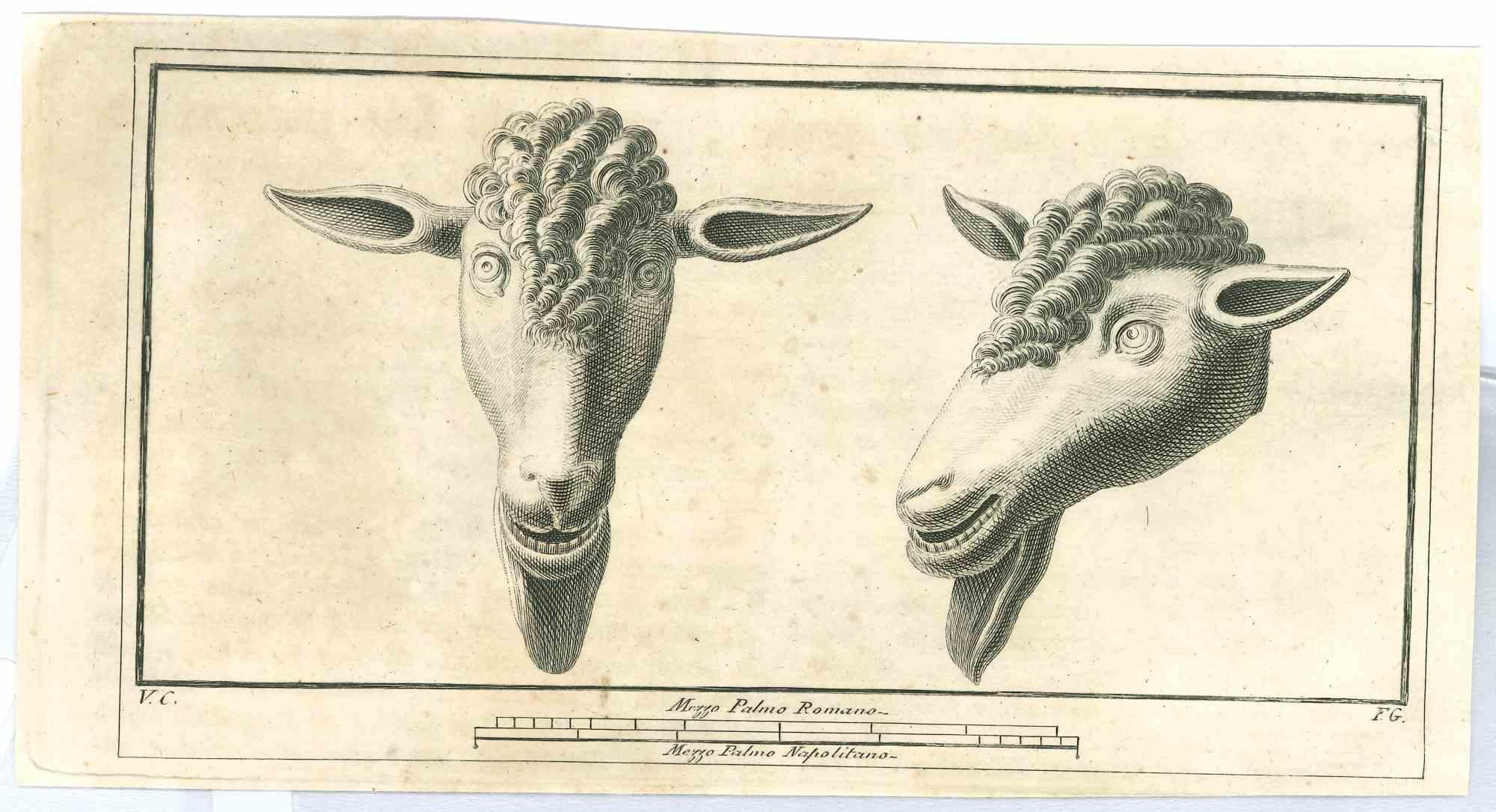Items Similar to Heads of Animals - Original Etching by John Barlow - 1810
Want more images or videos?
Request additional images or videos from the seller
1 of 5
John BarlowHeads of Animals - Original Etching by John Barlow - 18101810
1810
About the Item
Heads of animals is an original artwork realized by John Barlow (1759 - 1810).
Original Etching from J.C. Lavater's "Essays on Physiognomy, Designed to promote the Knowledge and the Love of Mankind", London, Bensley, 1810.
This artwork portrays heads of animals.
Good conditions, except for some stains.
Johann Caspar Lavater was a swiss theologian and philosopher known throughout Europe for his studies on physiognomy. Following the physiognomy tradition of Della Porta and of many Renaissance and Baroque philosophers, he believed that the character of a person could be elucidated through examining their “lines of countenance" i.e. tracing a profile outline portrait. Being able to "read outside" was the key to "know the inside". Lavater's thought largely influenced Art in the late 18th and early 19th century, as in the case of Johann Fuseli and William Blake (who realized two etchings for Lavater's english edition of his Essay).
- Creator:John Barlow (1759 - 1810)
- Creation Year:1810
- Dimensions:Height: 12.6 in (32 cm)Width: 10.24 in (26 cm)Depth: 0.04 in (1 mm)
- Medium:
- Movement & Style:
- Period:
- Framing:Framing Options Available
- Condition:Insurance may be requested by customers as additional service, contact us for more information.
- Gallery Location:Roma, IT
- Reference Number:Seller: T-1235541stDibs: LU65038763172
About the Seller
4.9
Platinum Seller
These expertly vetted sellers are 1stDibs' most experienced sellers and are rated highest by our customers.
1stDibs seller since 2017
6,682 sales on 1stDibs
Typical response time: 2 hours
- ShippingRetrieving quote...Ships From: Monaco, Monaco
- Return PolicyA return for this item may be initiated within 14 days of delivery.
Auctions on 1stDibs
Our timed auctions are an opportunity to bid on extraordinary design. We do not charge a Buyer's Premium and shipping is facilitated by 1stDibs and/or the seller. Plus, all auction purchases are covered by our comprehensive Buyer Protection. Learn More
More From This SellerView All
- Ancient Roman Statue - Original Etching by Vincenzo Campana - 18th CenturyBy Vincenzo CampanaLocated in Roma, ITAncient Roman Statue, from the series "Antiquities of Herculaneum", is an original etching on paper realized by Vincenzo Campana in the 18th century. Signed on the plate on the low...Category
Late 18th Century Old Masters Figurative Prints
MaterialsEtching
- Decoration With Animals - Etching by Luigi Aloja - 18th CenturyLocated in Roma, ITDecoration With Animals is an Etching realized by Luigi Aloja (1783-1837). The etching belongs to the print suite “Antiquities of Herculaneum Exposed” (original title: “Le Antichit...Category
Late 18th Century Old Masters Figurative Prints
MaterialsEtching
- Animals Pompeian Fresco - Etching by Aniello Cataneo - 18th CenturyLocated in Roma, ITAnimals Pompeian Fresco from "Antiquities of Herculaneum" is an etching on paper realized by Aniello Cataneo in the 18th Century. Signed on the plate. Good conditions. The etching...Category
18th Century Old Masters Figurative Prints
MaterialsEtching
- Ancient Roman Fresco Herculaneum - Etching by Carlo Nolli - 18th CenturyBy Carlo NolliLocated in Roma, ITAncient Roman Scene from the series "Antiquities of Herculaneum", is an original etching on paper realized by Carlo Nolli in the 18th Century. Signed on the plate. Good conditions...Category
Late 18th Century Old Masters Figurative Prints
MaterialsEtching
- Ancient Roman Fresco Herculaneum - Etching by Vanni - 18th CenturyLocated in Roma, ITAncient Roman Fresco from the series "Antiquities of Herculaneum", is an original etching on paper realized by Vanni in the 18th Century. Signed on the plate. Good conditions excep...Category
Late 18th Century Old Masters Figurative Prints
MaterialsEtching
- Ancient Roman Fresco Herculaneum - Original Etching G. Morghen - 18th CenturyBy Giovanni Elia MorghenLocated in Roma, ITAncient Roman Fresco from the series "Antiquities of Herculaneum", is an original etching on paper realized by Giovanni Elia Morghen in the 18th Century. Signed on the plate. Good ...Category
Late 18th Century Old Masters Figurative Prints
MaterialsEtching
You May Also Like
- Market DayBy Marius BauerLocated in Storrs, CTMarket Day. 1889. Etching and drypoint. Wisselingh 42. 7 5/8 x 5 13/16 (sheet 8 3/8 x 6 3/8). Edition 100. Printed on cream laid paper. Mat burn and toning ...Category
Late 19th Century Old Masters Figurative Prints
MaterialsEtching
- "Nohubo remedio" (There was no remedy) - Etching and Aquatint on PaperBy Francisco GoyaLocated in Soquel, CA"Nohubo remedio" (There was no remedy) - Etching and Aquatint on Paper Bold 3rd or 4th edition, circa 1868-1878, with burnished aquatints, drypoints etching, and engravings by Franc...Category
1790s Old Masters Figurative Prints
MaterialsEngraving, Paper, Etching, Aquatint
- A Fairy TaleBy Marius BauerLocated in Storrs, CTA Fairy Tale. 1897. Etching. Wisselingh 18. 2 3/4 x 4 3/8 (sheet 5 9/16 x 7 5/8). Edition 100, #51. A rich impression printed on cream laid paper. Signed an...Category
Late 19th Century Old Masters Figurative Prints
MaterialsEtching
- "Two Rams Looking Down & To Their Left, " Etching by Karel DuJardinBy Karel DujardinLocated in Milwaukee, WI"Two Rams Looking Down & To Their Left" is an original etching by Karel DuJardin. DuJardin completed many delicate etchings of rams. 3 3/4" x 7 3/4" art 16 3/8" x 19 1/2" frame Du Jardin was a master of various genres of painting, including refined and tranquil Italianising landscapes, monumental historical paintings and superb portraits of the aristocracy. Unlike the majority of his contemporaries, Karel du Jardin (b. Amsterdam 1626, d. Venice 1678) was a talented painter in not one, but many different genres. He is especially famous for his small-scale landscapes, such as the charming Italian landscape with a woman milking a goa" (1652) from the Rijksmuseum's collection. Du Jardin depicted both sun-filled Italianate scenes and Dutch farmyards with pigs and sheep. He also painted a range of elegant portraits of aristocrats and merchants. His self-portrait (1662) on copper is one of the most fascinating 17th-century portraits of a Dutch artist. Du Jardin's spectacular large-scale historical pieces, represented is the show by the impressive Conversion of Saint Pau" (1662) from the collection of the National Gallery of London, are among his most remarkable achievements; he often chose themes that were only rarely depicted by other Dutch painters of the period. During his own lifetime Du Jardin was praised by poets and writers, particularly for his attention to detail and elegant painting technique. As Cornelis de Bie, the artist’s biographer, wrote in 1661: "the surety of the brush at his finger and such sharpe clarity […] that the eye thereon doth linger." Du Jardin's valuable paintings were mainly purchased by rich individuals with an eye for elegance, but were also commissioned by prominent institutions such as the Amsterdam 'Spinhuis' (a women's prison), for whom he painted a vast group portrait of the prison-governors. Karel du Jardin was an artist who liked to travel. He lived for a time in Lyon and in Paris, and sailed with Joan Reynst, Heer van Drakestein, by ship via England, Portugal and Spain to Tangier and Algiers, where they met Michiel de Ruyter...Category
17th Century Old Masters Animal Prints
MaterialsEtching
- "Ram Eating Bark, " Etching signed by Karel DuJardinBy Karel DujardinLocated in Milwaukee, WI"Ram Eating Bark" is an original etching by Karel DuJardin. DuJardin completed many delicate etchings of rams. 3 3/4" x 7 3/4" art 16 3/8" x 19 1/8" f...Category
17th Century Old Masters Animal Prints
MaterialsEtching
- "Two Rams Facing Each Other, " Original Etching signed by Karel DuJardinBy Karel DujardinLocated in Milwaukee, WI"Two Rams Facing Each Other" is an original etching by Karel DuJardin. The artist signed the plate. DuJardin completed many delicate etchings of rams. ...Category
17th Century Old Masters Animal Prints
MaterialsEtching





